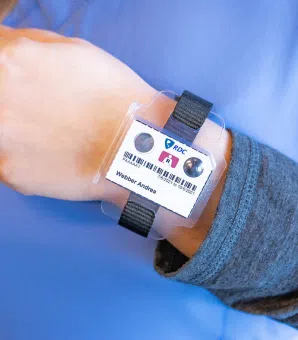
Dosimeter badge services for medical, dental, and veterinary businesses
Learn how Radiation Detection Company’s easy-to-use dosimetry solutions can boost the efficiency of your practice.

You've probably noticed that you're hearing more and more about OSL dosimeters these days. Your observation is correct. Over the past 25 or so years, optically stimulated luminescence (OSL) has increasingly become a viable and popular newer technology alternative to thermoluminescent dosimetry (TLD).
At RDC, we are dedicated to offering cutting-edge solutions to keep you and your organization safe. That is why we launched our OSL Dosimeter solutions.
In this article we'll take a deeper look at optically stimulated luminescence and its use in personal dosimetry. We hope you find this article informative and look forward to hearing your feedback!
Optically Stimulated Luminescence (OSL) is a method used to measure doses of ionizing radiation. There are two main applications of OSL.
Radiation dosimetry is the measurement of accumulated radiation dose in the tissues of health care, nuclear, research, and other workers
Luminescence dating is the dating of ancient materials, usually geological sediments. Types of luminescence dating include Optically Stimulated Luminescence, Thermoluminescence dating, and Infrared Stimulated Luminescence (IRSL). The age range covered by the various techniques extends from a few tens of years to almost a million years. Luminescence Dating can only be done using Aluminum Oxide, an ionic compound that we'll touch on more below.
We will be further exploring the first application of optically stimulated luminescence, as it applies to the measure of radiation doses in personal dosimetry.

A thermoluminescent dosimeter – more commonly called a TLD dosimeter – is currently the most common type of radiation dosimeter used. As ionizing radiation passes through a thermoluminescent dosimeter, electrons in the material are moved into dosimetric traps. The electrons are held there until the detector is heated up.
Once the temperature reaches a maximum of approximately 400oC, the trapped electrons begin to move. This movement causes a light pulse to be emitted, also known as luminescence.
In luminescence, only a small fraction of atoms (called the emission center or luminescence center), emit light. A photomultiplier tube (PMT) is then used to count the emitted light. The amount of light emitted is proportional to the amount of ionizing radiation exposure that the dosimeter received.
A TLD dosimeter is considered to be a passive radiation detection device and has become the most commonly used solid-state radiation detector for personnel monitoring (i.e. workers at nuclear power plants, in research laboratories, and medical fields - including those administering radiation therapy).
RDC offers multiple TLD badge solutions including: whole body, ring, wrist, fetal monitoring, and area TLD. To learn more about the TLD dosimeter and RDC's offerings, please check out our recent blog post titled, "Thermoluminescent Dosimeter [TLD] – Everything You Need to Know."
The material makeup of a TLD dosimeter and an OSL dosimeter is very similar, in that both are comprised of crystalline solids. Both dosimeters capture point dose measurements, or radiation doses in a relatively small volume.
An OSL dosimeter most commonly uses Beryllium Oxide (BeO) to absorb x-ray energy. It then releases it and measures the precise dose of ionizing radiation received. Beryllium Oxide is commonly used because it is extremely durable, sensitive, and resistant to environmental influences and fading. Some OSL dosimeters use Aluminum Oxide (Al2O3:C) instead of BeO.
OSL dosimeters are generally more sensitive than TLD dosimeters, with a lower limit of detection. The lower limit of detection (LLD) is the smallest amount of an analyte (a substance whose chemical components are being identified and measured) that can reliably be detected. LLD is also sometimes known as analytic sensitivity. In simpler terms, LLD is the lowest level of analyte that can be statistically distinguished from a completely blank sample.
The essential difference between a TLD dosimeter and an OSL dosimeter is that a TLD dosimeter requires heat, while an OSL dosimeter requires only optical stimulation.

You'll remember that dosimetry (commonly referred to as radiation dosimetry) is the accurate and systematic measurement, calculation, and assessment of the ionizing radiation dose absorbed by matter or tissue. Ionizing radiation is high-energy radiation. This includes x-rays (produced by electron beams), beta, gamma, ultraviolet, and neutron radiation, capable of producing ionization in the substances it passes through.
Optically stimulated luminescence is the process in which a pre-irradiated (already exposed to ionizing radiation) material - when exposed to an appropriate optical stimulation - emits a light signal proportional to the tissue equivalent dose.
Using OSL as a passive dosimeter provides the same capabilities of TLD dosimeters, but at a much faster pace and with the same or better efficiency. A major advantage is that OSL dosimeters provide the possibility of repeated readout. This means that OSL dosimeters are often archived for multiple years and can be re-read, as the dose does not fade.
TLD dosimeters can only be used once although LiF copper doped TLD’s don’t fade. While OSL dosimeters can be reused multiple times. OSL dosimeters can also be read at room temperature (unlike a TLD dosimeter which must be heated), which helps simplify the design. Another advantage is OSL dosimeters are not impacted by heat or water.
Choosing the right dosimetry solution can be very difficult. That's why our world-class customer service team is happy to guide you on the products we provide so you can make the best decision for your organization.
Radiation Detection Company has 75 years of experience providing quality dosimetry service to over 31,000 companies worldwide. Need help understanding what dosimeters your organization needs? Please contact us, and our team will be happy to provide guidance.
Need a question answered that we did not address in this article? Please reach out to our Customer Care team, and one of our specialists will be more than happy to help.
Learn how Radiation Detection Company’s easy-to-use dosimetry solutions can boost the efficiency of your practice.